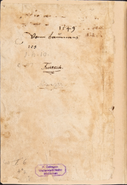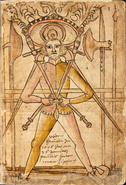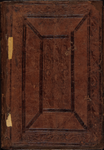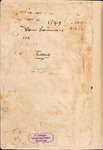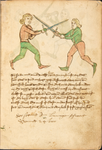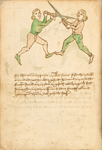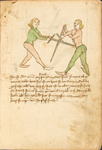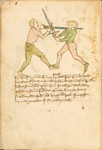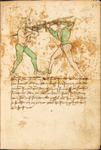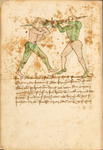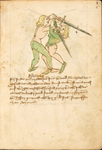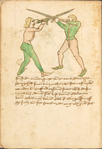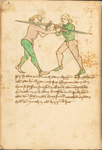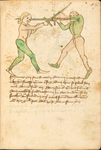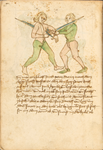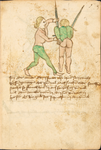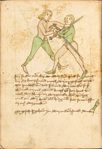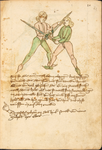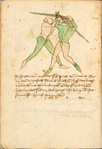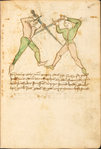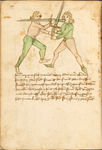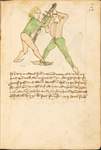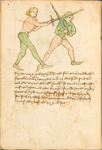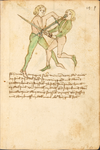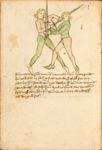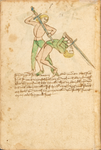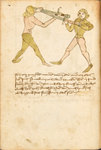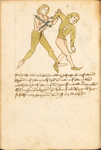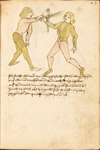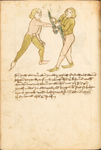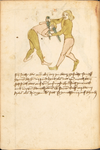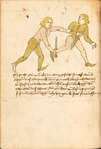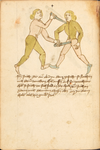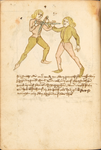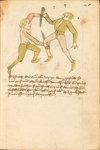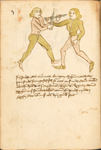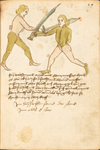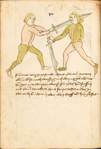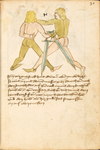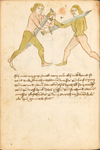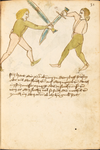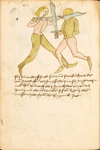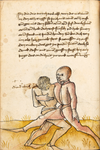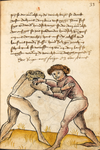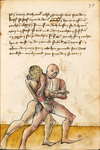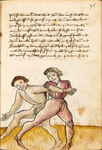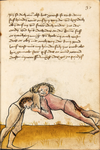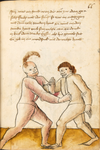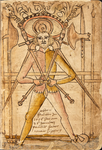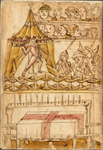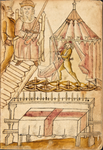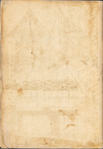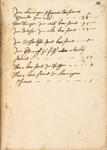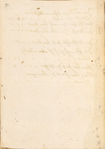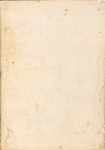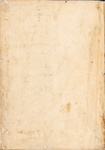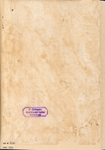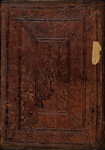|
|
You are not currently logged in. Are you accessing the unsecure (http) portal? Click here to switch to the secure portal. |
Bauman Fechtbuch (Cod.I.6.4º.2)
| Codex Wallerstein | |||||
|---|---|---|---|---|---|
| Cod.I.6.4º.2, Universitätsbibliothek Augsburg Augsburg, Germany | |||||
| |||||
| |||||
| Also known as | Von Bauman's Fechtbuch | ||||
| Type | |||||
| Date | ca. 1400/1470s | ||||
| Place of origin | Nuremberg, Germany | ||||
| Language(s) | Early New High German | ||||
| Author(s) | Unknown | ||||
| Compiler | Paulus Hector Mair (1556) | ||||
| Illustrator(s) | Unknown | ||||
| Material | Paper, with a modern binding | ||||
| Size | 110 folia | ||||
| Format | Double-sided; one illustration per side, typically with text above | ||||
| Script | Bastarda | ||||
| External data | Library catalog entry | ||||
| Treatise scans |
| ||||
Codex Wallerstein (or Codex I.6.4º.2) is a German fencing manual compiled by Paulus Hector Mair in 1556.[1] The original currently rests in the holdings of the Universitätsbibliothek Augsburg in Augsburg, Germany. It consists of at least three distinct treatises, based on the art style and the handwriting; the first two sections likely date to the 1470s, while the third is much older, from perhaps around 1400.[citation needed] The title "Vom Baumans Fechtbuch" appears at the beginning of the first treatise, perhaps indicating that Michael von Baumann owned the treatise, along with the date 1549. The first two sections seem to have been used by Albrecht Dürer as a reference for his own fencing manual.[2]
Codex Wallerstein is interesting in that its teachings do not seem to fall into the tradition of the grand master Johannes Liechtenauer. Part A, which treats longsword, messer, and dagger, and Part B, which treats grappling, are the first entries in a series of manuscripts known as the Nuremberg group, which originate from that area and seem to document the same martial tradition. Part C, on the other hand, is the first entry in a complex of treatises known as pseudo-Gladiatoria due to the fact that Hils originally ascribed it to the Gladiatoria group[citation needed] (another tradition not dependent on Liechtenauer). Ps-Gladiatoria covers the same sorts of dueling as the Gladiatoria group, but the differences are too extensive to classify them as versions of the same treatise.
Contents
Provenance
Contents
| Folio | Section | ||||||
|---|---|---|---|---|---|---|---|
| 1rv | Front matter
| ||||||
| 3r - 14v, 21r - 21v |
Longsword teachings from the Nuremberg tradition | ||||||
| 22r - 28v | Dagger teachings from the Nuremberg tradition | ||||||
| 29r - 32v | Messer teachings from the Nuremberg tradition | ||||||
| 15r - 20v, 33r - 73v |
Grappling teachings from the Nuremberg tradition | ||||||
| 76r - 80v, 101r - 102v |
Longsword from Pseudo-Gladiatoria | ||||||
| 81r - 95v, 103r - 108r |
Armored Fencing from Pseudo-Gladiatoria | ||||||
| 96r - 98v | Longshield from Pseudo-Gladiatoria | ||||||
| 98v - 100v | Grappling from Pseudo-Gladiatoria | ||||||
| 109r | Rear matter
|
Gallery
Images hosted by the Universitätsbibliothek Augsburg. Note that parts A and B are nested together in the current configuration of the manuscript.
Part A
Part B
Part C
Additional Resources
- Dörnhöffer, Friedrich. Albrecht Dürers Fechtbuch. Vienna: F. Tempsky, 1909.
- Dürer, Albrecht and Wassmannsdorff, Karl. Die Ringkunst des deutschen Mittelalters. Liepzig: Priber, 1870.
- Żabiński, Grzegorz and Walczak, Bartłomiej. Codex Wallerstein: A Medieval Fighting Book from the Fifteenth Century on the Longsword, Falchion, Dagger, and Wrestling. Boulder, CO: Paladin Press, 2002. ISBN 978-1-58160-585-3
References
- ↑ Dated on folio 1r.
- ↑ Albrecht Dürer. Untitled [manuscript]. MS 26-232. Vienna, Austria: Albertina, 1512.

